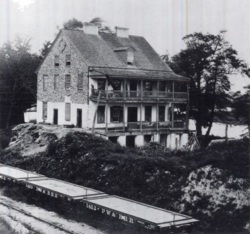Philadelphia, Wilmington, and Baltimore Railroad

PW&B flatcars sit outside the old Gray's Ferry Tavern in southwest Philadelphia, ca. 1870s
|
|
| Locale | Pennsylvania, Delaware and Maryland |
|---|---|
| Dates of operation | 1836–1902 (purchased 1880 by the Pennsylvania Railroad) |
| Predecessor |
Baltimore and Port Deposit Rail Road Company; Delaware and Maryland Rail Road Company; Philadelphia and Delaware County Rail-Road Company; Wilmington and Susquehanna Rail Road Company |
| Successor | Philadelphia, Baltimore and Washington Railroad (PB&W) - (1902-XXXX) |
| Track gauge | 4 ft 8 1⁄2 in (1,435 mm) standard gauge |
| Length | 669 mi (1,077 km) |
| Headquarters | Philadelphia |
Baltimore and Port Deposit Rail Road Company;
Delaware and Maryland Rail Road Company;
Philadelphia and Delaware County Rail-Road Company;
The Philadelphia, Wilmington and Baltimore Railroad (PW&B) was an American railroad company itself a result of merger of four small lines dating from the earliest days of American railroading in the late 1820s and early 1830s, that operated from 1836, until being bought by a larger regional line in 1881, with a merger into a longer Northeast Corridor railway in 1902. It built the first rail line south from Philadelphia into The South.
Founded in 1831 as the Philadelphia and Delaware County Rail-Road Company, the PW&B had within six years changed its name and merged with three other state-chartered railroads in three Middle Atlantic states to create a single line between Philadelphia, Pennsylvania and Baltimore, Maryland. In 1881, the PW&B came under the control of the Pennsylvania Railroad (PRR), the larger one of then two dominant rail.line companies in the Northeast United States.
An 1895 history of the PRR had this to say about the significance of the PW&B, which it had acquired and gained control of fourteen years before:
"An important constituent of a great North and South line of transportation, it challenges ocean competition and carries on its rails not only statesmen and tourists but a valuable interchange of products between different lines of latitude. As a military highway, it is of the greatest strategic importance to the national, industrial, and commercial capitals – Washington, Philadelphia and New York. It presents some of the very best transportation facilities to the commerce of the cities after which it is named and could not be obliterated from the railroad map of the United States without materially disturbing its harmony."
In 1902, the PW&B was merged into the PRR's owned and newly merged Philadelphia, Baltimore and Washington Railroad.
The old P.W. & B. line is still in use today as part of Amtrak's Northeast Corridor; and the Maryland state Department of Transportation's "MARC" commuter passenger system to the northeast corner of Maryland from Baltimore. Freight is handled by Norfolk Southern and formerly by the Conrail system.
...
Wikipedia
